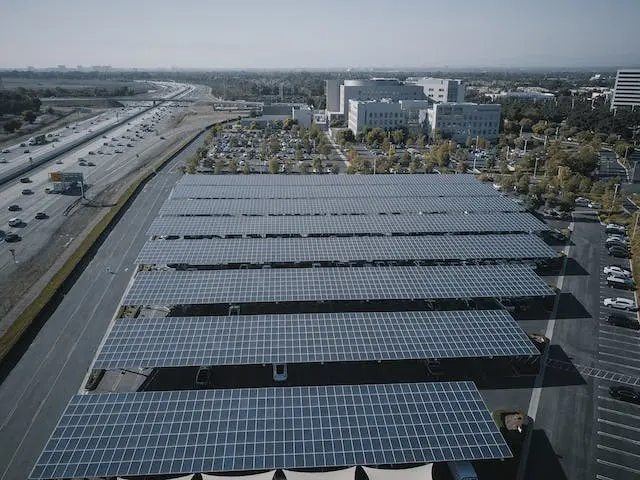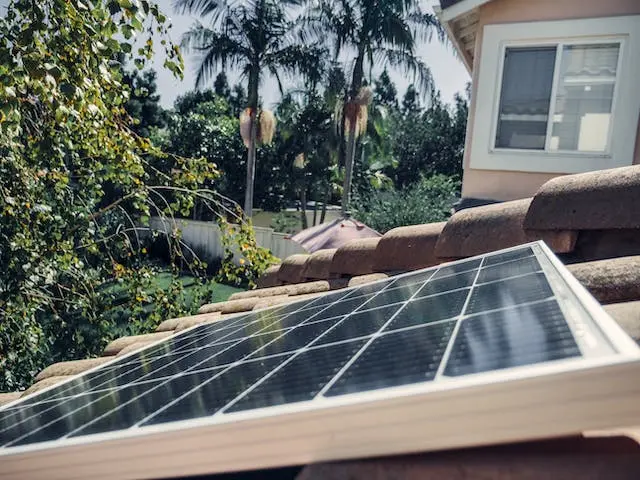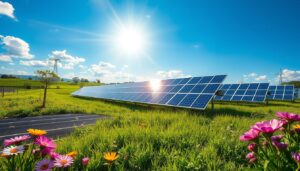It just so happens that the same fiery star that brightens your day also holds the key to mastering one of the most crucial calculations in solar energy: solar insolation.
You’ve likely heard that harnessing the sun’s power is a clean, renewable way to meet energy needs, but the real trick lies in understanding how much sunlight reaches a given area. As you’re about to discover, calculating solar insolation isn’t just about knowing your location’s latitude or the time of year; it’s a complex process influenced by an array of factors, from the angle of your solar panels to the atmospheric conditions overhead.
By breaking down the concepts and equations used by professionals, you’ll be equipped to accurately assess the solar potential of any site. However, be warned: once you’ve started peeling back the layers of this intricate process, you may find yourself captivated by the challenge of harnessing the sun’s energy as efficiently as possible.
Key Takeaways
- Location, tilt angle, and azimuth angle are crucial factors in maximizing solar insolation and energy production.
- Shading from trees or structures can significantly reduce energy collection.
- Equations, graphs, and data sources help in analyzing sunlight exposure and predicting energy yield.
- Precision, data interpretation, and optimization are essential for maximizing solar panel system efficiency.

Selecting Your Location
When it comes to harnessing solar energy efficiently, choosing the right location is a pivotal step, as it significantly influences the amount of solar insulation your panels will receive. Understanding optimal orientation and considering shading factors are crucial to maximizing energy production. You’ll need to account for latitude, local weather patterns, and elevation, each of these elements plays a role in how much sunshine hits your panels.
The tilt angle is another piece of the puzzle that can’t be overlooked. It’s not just about facing the sun; it’s about positioning your panels so they get the most direct sunlight throughout the year. Access insolation data for your specific location using resources like NASA’s website or insolation maps online to make informed decisions.
Additionally, you have to understand edge effects and correction factors that can impact the performance of your solar setup. Remember, it’s not just about the raw numbers. You’ve got to interpret this data, considering the unique characteristics of your site. Use alternative tools and calculators to get the tilt just right.

Understanding Solar Pathways
Having selected the ideal location for your solar panels, it’s essential to grasp how the sun’s journey across the sky affects the energy they’ll capture. Optimizing panel placement is a dance with the sun’s pathways; each day, its arc dictates where and how the light will fall. The tilt and azimuth angles of your panels aren’t just arbitrary numbers, they are critical to maximizing your energy harvest.
To help you visualize, let’s look at a table that simplifies these concepts:
|
Factor
|
Description
|
Relevance to Solar Insolation
|
|---|---|---|
|
Tilt Angle
|
Inclination of panels from horizontal
|
Optimizes angle of incidence
|
|
Azimuth Angle
|
Orientation relative to true south
|
Aligns with the sun’s path
|
|
Shading
|
Obstructions causing shadowing
|
Reduces insolation
|
|
Sun Hours
|
Duration of substantial sunlight
|
Determines daily potential
|
|
Seasonal Variation
|
Changes in the sun’s arc through the year
|
Influences annual efficiency
|
Understanding the impact of shading is also critical. Nearby trees or structures can cast shadows, significantly reducing the energy your panels can collect. Correctly calculating solar insolation with tilt involves knowing how these shadows move with the sun, and making sure your panels remain bathed in light as long as possible. Access robust data sources and tools to fine-tune your system, ensuring your solar venture truly shines.

Measuring Sunlight Exposure
To accurately gauge the sun’s bounty on your solar panels, you’ll need to dive into the equations that calculate solar insolation, taking into account the sun’s ever-changing position in the sky. These complex equations are pivotal in solar radiation measurement, as they consider the specific tilt angle of your surface and the sun’s annual journey.
Imagine a graph plotting the Intensity of Direct Radiation; it’s not just a flat line but a dynamic display showing how a tracking concentrator captures the sun’s power, sans clouds, across different days. This visual aid is crucial for in-depth solar irradiance analysis, helping you predict energy yield with precision.
Then there’s the Daily Solar Insolation as a Function of Latitude graph. It’s not just numbers; it represents the heartbeat of your solar setup, with curves ebbing and flowing to show the insolation on horizontal and tilted surfaces, varying with the day’s length which is dictated by your latitude.
Calculating Energy Potential
Understanding the solar insolation equations and theoretical graphs prepares you to now calculate the energy potential, a crucial step for maximizing your solar panel system’s efficiency. With the right equations in hand, you’re geared up to figure out just how much power your panels can potentially generate. This isn’t just about knowing numbers; it’s about optimizing panel placement and calculating efficiency to ensure you’re getting the most out of every ray of sunshine.
The energy potential is a game of angles and sunlight. You’ll use trigonometry to factor in the tilt of your panels, making sure they’re angled just right to catch the maximum amount of solar insolation. And remember, it’s not just about the tilt; the azimuth angle plays a key role too, affecting how the sun’s path influences your system’s performance.
But before you dive in, let’s talk data. Sources like NASA provide insolation data that’s crucial for your calculations. You’ll need this to accurately predict how much energy your panels will harness over time. You’ve got to consider local weather effects, and temperature corrections, and use the right correction factors. It might sound daunting, but with precision and a bit of savvy, you’ll master the art of calculating energy potential and set your solar system up for success.
Interpreting Insolation Data
Interpreting insolation data often seems daunting, but it’s essential for optimizing your solar energy system to its fullest potential. As you pore over graphs and charts, you’ll notice insolation trends that are critical for understanding how much sun your panels will soak up throughout the year. These trends can reveal how solar radiation intensity waxes and wanes, affected by factors such as the angle of incidence and the length of daylight hours.
Seasonal variations are particularly pivotal. You’ll observe how the Earth’s tilt and orbit cause fluctuations in daily solar insolation, changing the number of sunshine hours your location receives. Winter months might show a stark contrast to summer, affecting how much energy you can harness and store.

To navigate this information like a pro, dive into the equations for insolation calculations. These, along with correction factors, will sharpen your ability to predict energy production. Remember, interpreting this data isn’t just about numbers, it’s about tailoring your system for maximum efficiency.
Don’t shy away from high-tech tools, either. Utilizing resources like NASA databases or the JRC European Commission’s PVGIS can streamline the process, giving you a clearer picture of potential energy generation. In short, mastering insolation data interpretation equips you to make informed decisions for a robust solar setup.
Surprising Facts About Calculating Solar Insolation
- 🌐 The Earth’s atmosphere filters and scatters sunlight, causing only about 70% of the solar radiation to reach the Earth’s surface.
- 🌞 Solar insolation varies with the Earth’s distance from the sun, being about 7% higher in early January compared to early July due to the elliptical shape of Earth’s orbit.
- 🌍 The Earth’s axial tilt plays a crucial role in determining solar insolation at different latitudes, leading to the seasons.
- 🔍 Shadows cast by objects can affect local solar insolation, creating microclimates and influencing energy production in solar installations.
- 🌥️ Cloud cover significantly impacts solar insolation, with variations in cloudiness causing fluctuations in energy production from solar panels.
- 🌫️ Aerosols, such as pollution and natural particles, can scatter and absorb sunlight, affecting the amount of solar radiation reaching the Earth’s surface.
- 📏 The angle of incidence, or the angle at which sunlight strikes a surface, greatly influences the amount of solar energy that can be harvested.
- 🌅 Solar insolation is generally higher at higher altitudes due to the reduced thickness of the atmosphere, which allows more sunlight to reach the surface.
- 🌦️ The Solar Constant, the average solar irradiance at a distance of one astronomical unit from the sun, is approximately 1361 watts per square meter.
- 🔄 Over longer time scales, factors such as changes in solar output and Earth’s orbital variations can influence solar insolation and climate.
Frequently Asked Questions
How Do You Calculate Solar Insolation?
You’ll calculate solar insolation by considering insolation variables like tilt, azimuth, and local climate. Sun angles change with seasons, affecting your results. It’s not just about sunlight hours; precision is key for accuracy.
How Do You Calculate Solar Energy From the Sun?
To calculate solar energy from the sun, you’ll consider solar positioning and insolation variations, factoring in the tilt angle, local climate, and time of year to gauge your system’s potential energy capture.
What Is the Formula for Calculating Irradiance?
You calculate irradiance using the formula I = P/A or I = E/t. Factors like the solar constant and measurement challenges can affect accuracy, but these equations are crucial for understanding solar energy capture.
What Is the Pveducation Equation of Time?
The Pveducation Equation of Time accounts for time discrepancies caused by Earth’s eccentric orbit, ensuring you’re aligning solar panels precisely for optimal energy capture throughout the year. It’s a key tool in solar design.
Conclusion
In conclusion, mastering the calculation of solar insolation is the key to unlocking the full potential of your solar panel system. From choosing the optimal location and understanding solar pathways to measuring sunlight exposure and interpreting insolation data, precision is paramount. By delving into equations, and graphs, and utilizing high-tech tools, you can ensure your solar venture is not only efficient but also effective.
Remember, it’s not just about numbers; it’s about fine-tuning your system for maximum efficiency. As you navigate through the complexities of tilt angles, azimuth angles, and shading considerations, stay focused on accuracy. With the right knowledge and tools, you can harness the sun’s energy like a pro, ensuring your solar setup shines bright and contributes to a sustainable future.



